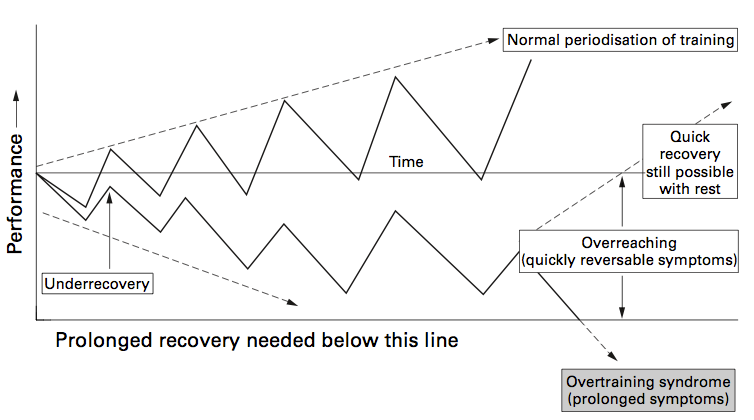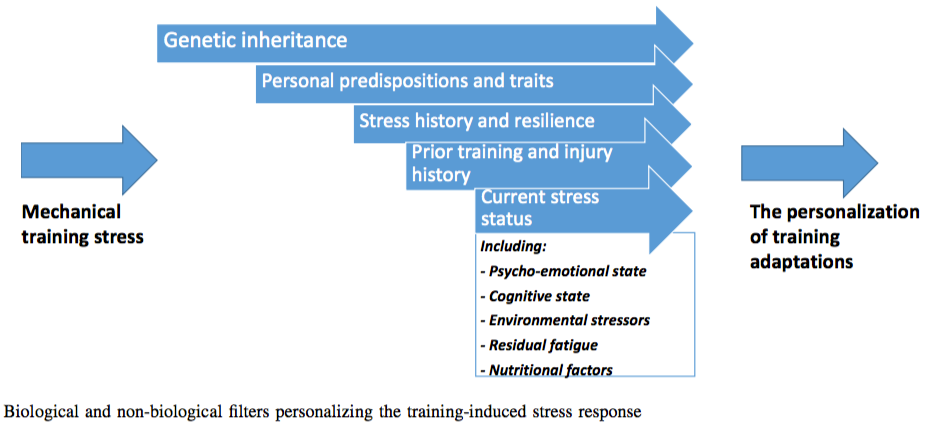The stress – adaptation response considered to underlie improvements in performance caused by training has hardly been questioned in almost 100 years. Now, a new and thought-provoking review paper questions the basis for this model, especially as it applies to human athletes living in the 21st century. The paper is written by Dr John Kiely from the Elite Performance Institute, University of Central Lancashire, UK.
What is Periodisation?
We use the term periodisation to refer to the alternation of loading and de-loading phases within training, balanced with appropriate periods of recovery in order to produce the desired supercompensation – the magic by which the athlete’s performance improves.

The concept of periodisation was borrowed from the stress theories proposed by Walter Cannon (1920) and Hans Selye (1930s-onwards). Cannon coined the term homeostasis to mean internal equilibrium. When that equilibrium was disturbed, the sympathetic ‘fight or flight’ response helped the animal deal with the stressor, and homeostasis was restored once the challenge had gone or been dealt with.
Selye’s General Adaptation Syndrome was based on the application of biological and mechanical stress to rodents, which reacted in similar ways for a variety of stress sources. He later said that he never considered the application of this model to sports training.
In reality, neither homeostasis nor the stress response are static; they vary with life experiences, bio rhythms and many other factors.
In fields outside sport science, the understanding of stress in human beings has advanced massively over the last 80 years, but the popular periodisation models used by coaches and athletes have not.
A cognitive response to stress
Psychologists now consider stress as a cognitive (mental) reaction to the perceived difference between a possible challenge and the ability of person to cope with that challenge. In other words, mental stress is not absolute, it depends on how we think about it, and the same challenge can produce markedly different stress responses in different people. In summary – stress responses are shaped by our perceptions; they are context specific and individual to each of us.
Homeostasis can be replaced by the more comprehensive term allostasis, which is a set of multi-level emotional, psychological, physiological, and immune system compensations that can be mobilised to match the specific situation that we find ourselves in.
When a threat is perceived, it is the emotional regions of the brain (the Chimp for the Steve Peters fans out there) which are the first to register the challenge and to coordinate the response. Interestingly, these emotional regions are also the first to demonstrate wear and tear when over worked by stressful situations. These regions become physically smaller in people who are chronically stressed.
The emotional context has a dramatic effect on the subsequent biological response
The original models on which periodisation is based bypass this cognitive phase and do not allow for it to vary with context in intensity or in specific actions.
Understanding the importance of the cognitive processing of stress opens new doors and many potential insights as to why athletes respond differently to training at different times. We are all aware that in medical contexts, high levels of life stress negatively affect health outcomes, but we are not so aware that there is good evidence that elevated levels of mental stress are a strong predictor of injury occurrence in athletes, and that traits such as self-blame and perfectionism make this worse.

So how is this relevant for the use of HRV in training?
The autonomic nervous system (ANS) is the major regulator of emotional state, using the sympathetic and parasympathetic branches we have come to know and love. Heart Rate Variability offers a precise window in to ANS activity.
Professor Stephen Porges has studied the involvement of the ANS in emotion regulation his whole working life, and has proposed the following escalation of reactions to challenges faced by mammals:
- Parasympathetic withdrawal (HRV down)
- Sympathetic activation (HRV down, HR up)
- Parasympathetic dominance (HRV up a lot)
This third state is sometimes called the ‘freeze & feign death’ state which is present in some animals in the face of severe life threatening challenges but it has not been conclusively demonstrated in humans. Unusually high HRV is however sometimes associated with exhaustion in athletes as well as in chronic fatigue syndrome.
HRV is a holistic stress indicator, and this new model helps us to see why certain training, for instance HIIT, is more effective when performed on a high HRV day, when background and overall stress levels are lower.
Higher levels of HRV are associated with higher levels of resilience, lower day to day variation and improved adaptation.
Conclusions
This review paper has been the source of some controversy, since not everyone is ready to throw out the model which has allowed periodised training programs to be designed for so many decades. Periodisation is still a useful concept, it’s just not the complete picture we might have thought.
Once my eyes were opened to this way of looking at the multiple factors that influence the way adaptation to exercise occurs, I was quickly able to find other studies supportive of this view. For instance, as recently as the end of last year, researchers in Spain found a significant performance reduction in young (15 year old) swimmers who performed a 1500m trial following 30 mins of mentally demanding tests vs those who watched an emotionally neutral video for the same period.
In another study, reported on by Superhuman Radio back in 2014, undergraduate students first completed questionnaires in life stress, then took part in a heavy resistance exercise routine. Their recovery of maximal muscle force, perceived energy and soreness were monitored in 24hr intervals. It was found that life stress scores significantly influenced recovery of maximal muscle force, energy and soreness, with the strongest relationship being observed interestingly between mean perceived stress and the objective measure of muscle force rather than perceptions of soreness and energy.
The Superhuman Radio article concluded:
There are probably a million reasons why stress impacts recovery. Just one example is that many of the inflammatory signals necessary for recovery and adaptation are dysregulated by stress. Moreover, sleep, diet, social support, and general behavior of the individual are other factors that influence stress and recovery in a complex manner. These factors may account for both the vulnerability of some people and the resilience of others when faced with stress. Overall, this study provides strong support in favor of “less is more” when stressed. If you have a lot going on in your life, that may be the perfect time to dial back your training and focus on getting things sorted out.
Our own conclusion is backed up by almost a decade’s worth of experience with HRV monitoring in thousands of people, i.e. that total stress, as reflected by HRV affects the ability of the individual to recover and adapt successfully to training.
In summary
Our recommendations on how to use this new understanding together with HRV monitoring are as follows:
- Find out which stresses affect you most and make them a priority for improvement. For most people, training is not the biggest source of stress – work, relationships, poor diet and lack of sleep are!
- Do your most demanding training (incl. HIIT) on high HRV days.
- Include sufficient variety in training to avoid the stress of boredom and keep motivated – both too little (monotony) and too much variety (lack of structure) will lead to inferior results.
- HRV trending higher over a period of several weeks together with reduction of day to day variability are signs of successful adaptation.
- During periods when life stress cannot be avoided, you may have to back off the training volume & intensity to avoid illness and injury.
- Higher baseline HRV = higher resilience. If your HRV baseline is on the low side increase the amount of Zone 1/2 aerobic training, improve your diet, and find better ways of managing mental stress. Aim to build resilience to emotional, as well as physical training load stress sources, using techniques like slow deep breathing, mindfulness, and meditation.
There is a lot more in the original article than we have been able to summarise, so we recommend you read & enjoy it – it’s available for free at the link below.
Reference
Periodization Theory: Confronting an Inconvenient Truth, Kiely, J. Sports Med (2017)

This really is a well written & thought provoking paper so I would encourage anyone who’s serious abut their training & health to download & read it.
Periodization Theory: Confronting an Inconvenient Truth, Kiely, J. Sports Med (2017)
https://doi.org/10.1007/s40279-017-0823-y
Great article Simon!
This is my philosophy to training too. It’s about monitoring ‘total’ stress and not just measuring a response to training. HRV is absolutely the perfect metric for measuring/monitoring total stress which takes account of the balance between parasympathetic and sympathetic which all factors including physiological, psychological, emotional, etc all feed into.
I’ll be downloading the paper and having a read.
Thanks Bernie. Reading this paper was a lightbulb moment for me. Several times I’ve had to explain why Garmin devices with Firstbeat software were giving different recovery prognoses (based on training only) to ithlete HRV, but now the reasons are clearly and authoritatively written down in this reference.